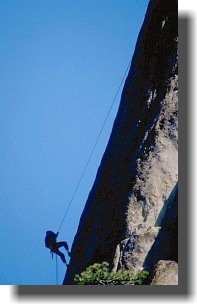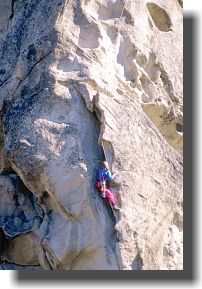|

What
is Mountain Climbing (Mountaineering)

 Vertical
height is the difference between hiking and climbing. Mountain climbing
is ice faces, ridges, rock crags, rock faces, alpine meadows and lakes,
icefalls and glaciers. It means learning to read topography maps and
compasses. Mountaineering also means, you will learn about repelling,
how to rope up, how to traverse crags, crevices and crevasses. This
very strenuous sporting activity calls for stamina, proper climbing
gear and careful planning. Vertical
height is the difference between hiking and climbing. Mountain climbing
is ice faces, ridges, rock crags, rock faces, alpine meadows and lakes,
icefalls and glaciers. It means learning to read topography maps and
compasses. Mountaineering also means, you will learn about repelling,
how to rope up, how to traverse crags, crevices and crevasses. This
very strenuous sporting activity calls for stamina, proper climbing
gear and careful planning.
The
Back Country:
British
Columbia back country is often undeveloped trails. It means stream
crossing, making your way through dense bush, and log walking. There
are definitely some signs to watch for when heading into the back
country. Stay out of burns, they are messy and full of fallen timber.
Avoid moraines and slide alder areas as they can be unstable. Where
possible, stay to ridge crests because the under brush will be less
in these areas.
Back
Country Travel:
Many
difficult and back country hiking trails also serve as the starting
point of mountain climbing sites. In certain areas of the province
logging roads offer access to the remote wilderness. Logging companies
often bar roads or lock gates between 6:00 a.m. and 6:00 p.m. on work
days and during high fire hazard periods. Vehicles with good high
clearance, four-wheel or rear-wheel drive are the best types to use
on any logging road. Most logging roads are not ploughed or maintained
during the winter months. Travel on back roads means self reliance
and care. Make sure the vehicle is equipped with good tires and has
plenty of fuel. Carry a first aid kit, clothing that is warm and waterproof,
plenty of water and food.
In the
southwestern section of British Columbia, the timberline runs from
about 1600 metres (5200 ft.) to 1800 metres (6000 ft.). It is a bit
higher in the interior and lower on Vancouver Island. Allow approximately
an hour for every kilometre when back country travelling and about
the same for every 150 metres (500 ft.) of elevation. Always be aware
of the surroundings and look back, as features and landmark look different
when approached from another direction. Rely on your map and compass
when in the wilderness.
Weather:
Weather
in mountainous terrain is very unpredictable, always be prepared.
In winter storms are frequent and whiteouts are common year round
near glacial sheets. Mountain tops or summits because they attract
clouds can be stormy, while the rest of the area is warm and sunny.
No matter what the weather, take rain gear. If camping, take a tent,
sleeping bag and camp stove. Check the local long range weather forecast
before going out on any climb.
 The
Hazards of Mountain Climbing (Mountaineering): The
Hazards of Mountain Climbing (Mountaineering):
Crossing
Creeks and Rivers:
Water
flow in any creek or river can vary greatly from one day to the next.
A rain storm or melting snows can quickly cause a small, shallow stream
to become a torrent of water. When crossing any stream, loosen the
straps on your pack and be ready to throw if off. Learn the art of
log walking, as it will be necessary. When crossing water on a log,
walk or crawl forward and do not look down.
Falling
Rocks and Avalanches:
Rockfall
happens when loosened by melting or climbers. When a group is climbing,
do so in a diagonal pattern to avoid rocks hitting members of the
party. Travel early in the morning before the ground starts melting.
Avalanches are different and are more command in winter and spring,
but do occur anytime of the year. All mountaineers should learn to
recognize the signs of a possible avalanche. They are more likely
to happen during and after heavy snowfalls accompanied by strong winds.
During the spring and summer, avalanches are triggered when the warm
sun and melting conditions weaken the snowpack. Snow that is hanging
over a ledge or cliff is always a hazard and can cause slides. Watching
for avalanches and rockfall is essential, no matter when or where
you are climbing.
Glaciers:
Approach
all glaciers with caution. Glaciers are hazardous because of hidden
crevasses, ice avalanches and how to stop from sliding without the
help of an ice-axe. Never venture over a glacier or a steep snow slope
unless properly equipment and experienced.
Mountain
Climbing (Mountaineering) Ethics:
Mountain
climbers have a set of fixed rules that all who enjoy this sport respect.
Never use unnecessary equipment that could damage the rocks. Do not
litter. Damage to the environment is unacceptable. Ethics is respecting
the great outdoors and other climbers who will follow.
 Winter
Mountain Climbing (Mountaineering): Winter
Mountain Climbing (Mountaineering):
Cooler
temperatures, snowfall and shorter days, make winter climbing a challenge.
Although snow and cool temperatures happen in the spring and fall,
the most demanding conditions happen in winter. It is during the months
between December and March that climbers must face the mountain on
its terms.
Ratings:
This
is the Yosemite Decimal System of rating:
Class
1 - Hiking.
Class 2 - Struggled hiking.
Class 3 - Rope not needed, but some handholds are needed for balance.
Class 4 - Roping up required and climbers travel together or put in
belays are
used at each pitch start.
Class 5.0 to 5.4 - Easy roped climbing with occasional use of chocks.
Class 5.5 to 5.7 - Moderate roped climbing, need good technical skills.
Class 5.8 - Difficult climbing.
Class 5.9 and up - Difficult and strenuous roped climbing. Good technical
skills
and climbing experience needed.
Take
lessons from a qualified instructor before trying any mountain climbing.
If you are a novice climber, always go out with someone who is experienced
and knows the mountains and surrounding area. Never go out alone and
always leave word with someone where you are going and when you plan
to be back.
There
are many items to consider before climbing any mountain. Such as,
are you mentally and physically fit to make the climb? Is your equipment
in top notch condition? Have you checked weather conditions? No two
mountains are the same. Each climbing experience is different. Be
safe, have fun!
| 


 Vertical
height is the difference between hiking and climbing. Mountain climbing
is ice faces, ridges, rock crags, rock faces, alpine meadows and lakes,
icefalls and glaciers. It means learning to read topography maps and
compasses. Mountaineering also means, you will learn about repelling,
how to rope up, how to traverse crags, crevices and crevasses. This
very strenuous sporting activity calls for stamina, proper climbing
gear and careful planning.
Vertical
height is the difference between hiking and climbing. Mountain climbing
is ice faces, ridges, rock crags, rock faces, alpine meadows and lakes,
icefalls and glaciers. It means learning to read topography maps and
compasses. Mountaineering also means, you will learn about repelling,
how to rope up, how to traverse crags, crevices and crevasses. This
very strenuous sporting activity calls for stamina, proper climbing
gear and careful planning.  The
Hazards of Mountain Climbing (Mountaineering):
The
Hazards of Mountain Climbing (Mountaineering): Winter
Mountain Climbing (Mountaineering):
Winter
Mountain Climbing (Mountaineering):